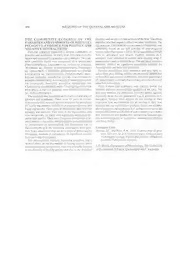
The community ecology of the parasites and symbionts of Portunus pelagicus: evidence for positive and negative interactions PDF
Preview The community ecology of the parasites and symbionts of Portunus pelagicus: evidence for positive and negative interactions
408 MEMOIRS OF THE QUEENSLAND MUSEUM THE COMMUNITY ECOLOGY OF THE chamber and on the external surfaces of the host, The rhizo- PARASITES AND SYMBIONTS OF PORTUNUS cephalan also had negative effects on other symbionts, The PELAGICUS: EVIDENCE FOR POSITIVE AND ege predalor, Carcinonemertes mitsukurii (Nemertea), was NEGATIVE INTERACTIONS commonly found on the gill lamellae of post-ovigerous Portunus pelagicus possessed a diverse community of female crabs (Prevalence ~ 53%). In the sacculinised female parasites and symbionts. In 1989, over 200 crabs were dis- host, C. mitsukurii was absent. Further, roouets os S. sected and examined [or parasites and symbionts. The com- granifera were observed in contact with recently dead P. mon symbiont fauna was comprised of 6 prolozoans moretonensis, and Levinseniella sp. The statistical analyses, [Operculariella sp., Lagenophrys sp.. Acineta sp. (ciliates), however, showed no significanl association between the Thelohania sp., Ameson sp.(microsporidians), Nematopsis thizocephalan and these two helminths. sp. (gregarine)}; 5 helminths [planocercoid turbellarian, Positive associations were numerous and may have re- Levinseniella sp. (metacercaria), Polypocephalus more- sulted from prey finding abilities (planocercoid turbellarian tonensis (cestode), telraphyllid cestode, Carcinonemertes vs branchial and external symbionts), host food preferences mitsukurtt (nemertean)}; 4 crustaceans [Chaniosphaera indi- (P. moretonensis vs tetraphyllid cestode), or association with cus (copepod), Sacculina granifera, Octolasmis cor, other host behaviours. * Chelonibia sp. (cirripedes)], and 647 fouling organisms from Here, 1 show that symbionts may interact within and other phyla, A few rare parasites were found (Puranophrys between different microhabitats (guilds?) of the host. The sp., Hematodinium sp.). host may mediate the interaction between certain species, The sand crab may possessed an interactive community of especially those that are pathogenic, e.g. S, granifera vs C. parasites and symbionts. There were |! pairs of interac- mitsukurii, because these species do not overlap in their tions/associations between species measured by prevalence tespective host microhabitats but do overlap in their host (X°) or by log-intensily (ANOVA on presence/absence, and resource use, ¢.g. reproductive products. Lastly, the commu- linear regression). Three pairs of interactions were between nity of parasites and symbionts in P. pelagicus did not fil the protozoa and metazoa. Five pairs in the log-intensity data current definitions and models of communities and commu- were reciprocals, i.¢. there were significant interactions be- nity interactions that predict few interactions between spe- tween both species. There were 3 negative associations (Car- cies in between guilds in 8isolationist9 communities (Holmes cinonemertes vs Sacculina, Polypocephalus (a lecanicephalid) and Price, 1986) vs Levinseniella (a microphallid), and Octolasmis cor vs Operculariella sp.): the remaining, associations were pasi- Literature Cited live. Since association may not be a result of direct species Holmes, J.C. and Price, P.W. 1986. Communities of para- interaction, methods to substantiate the significant associa- sites. 187-213. In D.J. Anderson and J. Kikkawa (eds) tions are being investigated. 8Communily ecology: Pallern and process9. (Blackwell The rhizocephalan barnacle, Sacculina grantfera, had a Scientific Publications: Oxford). marked effect on the assemblage of fouling species. Since sacculinised crabs do not moult, there was a notable increase J.D, Shields, Department of Parasitology, The University in the diversity of foulmg species that live in the branchial of Queensland, St Lucia, Queensland 4067, Australia.
